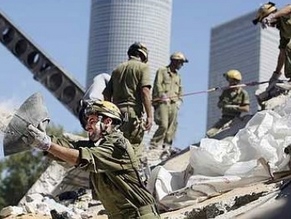|
World Jewish News

Home Front Command drill in Tel Aviv Photo by: Alon Ron
|
IDF upgrades notification system in face of growing missile threat
09.03.2012, Israel The Israel Defense Forces has acquired a new system that will let it see exactly where every missile strike has landed if the home front is under attack.
The new system is a modification of an existing command-and-control system called Castle Lake, which gives details on the location of Israeli forces and, as far as they are known, of enemy targets - anything from rocket launchers to enemy commanders.
With the modification, Castle Lake will now also display a map of the country on which every missile that hits will be marked. In addition to giving the location of the hit, the system will provide information on what kind of missile was launched, how much damage it caused and how long the home front has been under assault. That will enable commanders to factor developments on the home front into their operational decisions.
The home front data will also enable commanders to evaluate the effectiveness of Israel's operations against the enemy: for instance, whether attacking a Hezbollah stronghold in Lebanon had any effect on the rate of rocket launches from Lebanon.
The system was used for the first time last week, as part of a large-scale war games exercise.
"Essentially, commanders can see the effectiveness of the decisions they made and the way in which forces are being deployed," an officer in the army's C4I directorate explained. "It will be possible to go into the details of every launch - where it was fired from, what kind of missile it was, and how much damage it caused."
Last month, speaking at the annual Herzliya Conference, Military Intelligence director Maj. Gen. Aviv Kochavi warned that there are currently some 200,000 rockets and missiles aimed at Israel. MI estimates that most of these missiles have a maximum range of 40 kilometers, but thousands of them have ranges of hundreds of kilometers.
"These ranges cover all of Gush Dan, from Syria, Lebanon and Iran," said Kochavi, referring to the coastal plain around Tel Aviv. "The warheads on these missiles are becoming ever more deadly, weighing hundreds of kilograms. They are becoming ever more accurate, and the entire network is becoming more dispersed, more concealed, and more integrated into an urban environment. Every tenth house in Lebanon has a missile arsenal or a launching pad."
Kochavi's remarks underscored the growing missile threat on Israel's home front. While the Home Front Command has been working on a plan to reinforce buildings in the most vulnerable parts of the country, even after it is complete, 1.5 million Israelis will lack appropriate access to shelters.
During the Second Lebanon War of 2006, some 4,000 rockets were launched at Israel. The IDF expects the number of missile launches in the next war to be ten times that figure, of which it expects several thousand to actually hit: around 7,500 to 10,000 short-range rockets, 1,800 to 2,300 medium-range rockets and some 300 long-range rockets. It predicts that these missiles will kill about 200 civilians and destroy thousands of homes.
To counter this, Israel has developed a range of missile-defense systems, including Iron Dome for short-range rockets, David's Sling (also known as Magic Wand ) for medium-range missiles and the Arrow for long-range missiles. The IDF believes that nine Iron Dome batteries could protect a sizable percentage of the population in any future war, and that without these batteries, civilian deaths would be double the 200 cited above.
Nevertheless, IDF officers stress that these systems can't provide hermetic protection: People will still have to run for shelters if they want to maximize their chances of survival.
By Gili Cohen
Haaretz.com
|
|
